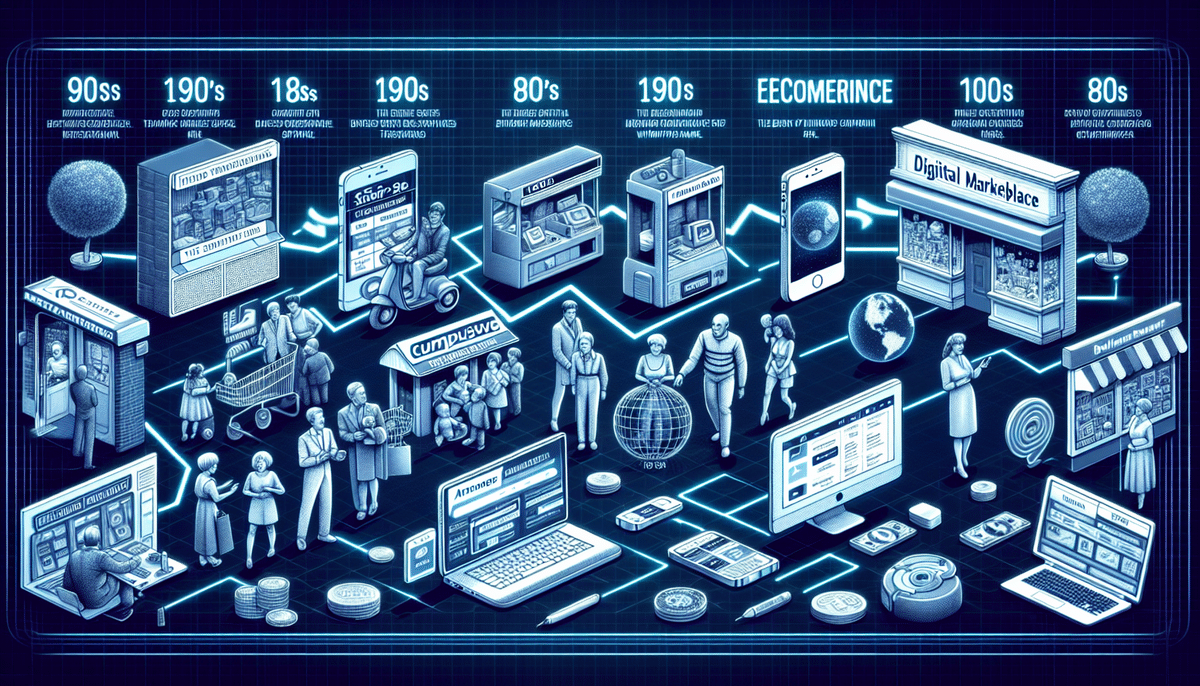Exploring the History of Ecommerce: How We Got Here
In today's fast-paced and technologically advanced world, ecommerce has become a significant part of our lives. From buying groceries to purchasing a car, ecommerce has revolutionized the way we shop and conduct business. According to Statista, global ecommerce sales are projected to reach $6.54 trillion by 2023. In this article, we will take an in-depth look at the history of ecommerce and how it has grown to where it is today.
The Early Days of Ecommerce: A Brief Overview
The concept of ecommerce dates back to the 1960s when researchers at the Massachusetts Institute of Technology (MIT) used a primitive form of the internet, known as ARPANET, to conduct business transactions. However, it wasn't until the 1980s that ecommerce gained momentum with the advent of online services like CompuServe and America Online (AOL). These platforms offered dial-up internet services, allowing businesses to connect directly with consumers and enabling them to purchase goods and services online.
As the internet became more widely available in the 1990s, ecommerce continued to grow at an unprecedented rate. Online marketplaces like Amazon and eBay emerged, offering consumers a wider range of products and services than ever before. This shift led to significant changes in consumer behavior, with more people choosing to shop online rather than in physical stores.
Today, ecommerce is a multi-trillion dollar industry that continues to evolve and innovate. With the rise of mobile devices and social media, businesses are finding new ways to connect with consumers and offer personalized shopping experiences. From virtual reality shopping to same-day delivery, the future of ecommerce is full of exciting possibilities.
The Birth of Online Shopping: From Idea to Reality
The first online shopping site, "The Electronic Mall," was launched in 1994 by Dan Kohn. This site allowed consumers to purchase goods and services from a variety of vendors using a secure payment system. The success of The Electronic Mall paved the way for other retailers to launch their own ecommerce sites, such as Amazon and eBay.
As online shopping gained popularity, retailers began to realize the importance of creating user-friendly and visually appealing websites. This realization led to the development of new technologies and design strategies, such as responsive web design and mobile optimization, to enhance the online shopping experience for customers.
Today, online shopping has become a staple in modern society, with millions of people around the world making purchases online every day. The convenience and accessibility of online shopping have revolutionized the way we shop, making it easier than ever to find and purchase products from the comfort of our own homes.
The Rise of Internet Retailers: A Game Changer for Ecommerce
The early 2000s saw the rise of major internet retailers, including Amazon, eBay, and Alibaba. These companies became household names, and ecommerce began to gain mainstream acceptance. They offered consumers a wide selection of products, competitive pricing, and the convenience of shopping from their own homes.
As internet retailers continued to grow in popularity, traditional brick-and-mortar stores began to feel the pressure. Many retailers struggled to keep up with the changing landscape of ecommerce and were forced to adapt or close their doors. However, some retailers successfully integrated their physical stores with their online presence, offering customers the option to shop in-store or online. This omnichannel approach has become increasingly popular, allowing retailers to reach a wider audience and provide a seamless shopping experience for their customers.
The Impact of Mobile Devices on Ecommerce: A Revolutionary Shift
The introduction of smartphones and tablets in the late 2000s had a significant impact on ecommerce. Mobile devices enabled consumers to shop on the go, and ecommerce sites had to adapt to the new mobile landscape. Retailers began offering mobile apps and optimizing their sites for mobile browsing, leading to an increase in mobile sales. As of 2023, over 72% of ecommerce sales are made via mobile devices.
Furthermore, the rise of mobile devices also led to the emergence of new payment methods such as mobile wallets and contactless payments. These payment options have made the checkout process faster and more convenient for consumers, resulting in higher conversion rates for ecommerce businesses. Additionally, mobile devices have enabled retailers to offer personalized shopping experiences through location-based services and push notifications, which have proven effective in increasing customer engagement and loyalty.
The Evolution of Payment Methods in Ecommerce: From Credit Cards to Cryptocurrency
The early days of ecommerce saw consumers using credit cards to make purchases online. However, as technology evolved, new payment methods were introduced, such as PayPal, Apple Pay, and Google Wallet. More recently, cryptocurrency has entered the ecommerce market, offering consumers a more secure and private way to make online purchases.
One of the main advantages of using cryptocurrency for ecommerce transactions is the increased security it provides. Unlike credit cards, which can be easily hacked or stolen, cryptocurrency transactions are encrypted and decentralized, making them much more difficult to hack or steal. Additionally, cryptocurrency transactions are anonymous, meaning that consumers can make purchases without revealing their personal information.
Despite the benefits of cryptocurrency, it remains a relatively new payment method in ecommerce, and many consumers are hesitant to use it. This hesitation is partly due to the volatility of cryptocurrency values, meaning that the value of a consumer's purchase could fluctuate significantly between the time they make the purchase and the time the transaction is completed. As such, it is important for ecommerce businesses to educate consumers about the benefits and risks of using cryptocurrency and to provide them with the necessary tools and resources to make informed decisions about their payment options.
The Emergence of Social Media and Its Role in Ecommerce Marketing Strategies
The emergence of social media platforms like Facebook, Twitter, and Instagram has transformed the way retailers market their products. Social media has become a crucial tool for ecommerce sites to connect with consumers and promote their products. Retailers can use social media to offer exclusive deals, promotions, and coupons, and communicate directly with customers.
In addition, social media allows retailers to gather valuable data on consumer behavior and preferences. By analyzing social media engagement and interactions, retailers can gain insights into which products are popular, what types of content resonate with their audience, and which marketing strategies are most effective. This information can then be used to optimize ecommerce marketing strategies and improve overall business performance.
Globalization and Cross-Border Ecommerce: How It's Changing the Game
The rise of ecommerce has led to a global marketplace, where consumers can purchase products from anywhere in the world. Cross-border ecommerce has opened up new markets for retailers and allowed consumers to access a wider range of products. However, cross-border ecommerce also presents unique challenges, such as language barriers, cultural differences, and logistics issues.
One of the biggest advantages of cross-border ecommerce is the ability for small businesses to compete on a global scale. With the rise of online marketplaces and social media, it's easier than ever for small businesses to reach customers in other countries. This has led to a more diverse and competitive marketplace, where businesses of all sizes have the opportunity to succeed.
How Big Data Analytics is Reshaping the Future of Ecommerce
The vast amount of data generated by ecommerce sites has elevated the importance of big data analytics. Retailers can use this data to gain insights into consumer behavior and preferences, improve their marketing strategies, and personalize the shopping experience. According to a report by McKinsey, businesses that leverage big data analytics are 5% more productive and 6% more profitable than their competitors.
One of the key benefits of big data analytics in ecommerce is the ability to optimize pricing strategies. By analyzing data on consumer behavior, retailers can determine the optimal price points for their products, taking into account factors such as demand, competition, and seasonality. This helps retailers maximize their profits while still offering competitive prices to consumers.
Another area where big data analytics is making a significant impact in ecommerce is supply chain management. By analyzing data on inventory levels, shipping times, and customer demand, retailers can optimize their supply chain operations to ensure that products are delivered to customers quickly and efficiently. This optimization helps retailers reduce costs, improve customer satisfaction, and gain a competitive edge in the market.
The Role of Artificial Intelligence in Ecommerce: Enhancing Customer Experience and Sales Revenue
Artificial Intelligence (AI) has become an increasingly important tool for ecommerce sites, enabling them to provide a personalized shopping experience for each customer. AI-powered chatbots can answer customer queries in real-time, recommend products based on browsing history, and even offer discounts to encourage purchases. Additionally, AI is used to optimize supply chains and improve logistics, leading to increased efficiency and profitability for retailers.
One of the most exciting developments in AI for ecommerce is the use of predictive analytics. By analyzing customer data, AI algorithms can predict which products a customer is likely to purchase in the future, allowing retailers to tailor their marketing and sales strategies accordingly. This not only improves the customer experience but also increases sales revenue for the retailer.
Furthermore, AI can help ecommerce sites identify fraudulent activity and prevent cyber attacks, ensuring the safety and security of customer data. According to a study by IBM Security, companies can save an average of $3.86 million per data breach by implementing AI-driven security measures.
In conclusion, the history of ecommerce has been a fascinating journey, from its early beginnings as an experimental research project to a multi-trillion dollar industry that has changed the way we shop and do business. As technology continues to evolve and consumer preferences shift, ecommerce will undoubtedly continue to innovate and shape the future of commerce.






















